

Virtual Procedures and Routines: How Alonzo Hall and Linda Fraser Set Student... Having strong procedures and routines is one of the most important things you can do to support learning in a bricks and mortar classroom.
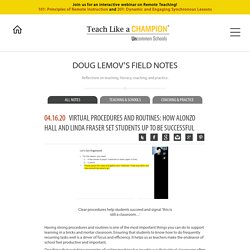
Ensuring that students to know how to do frequently recurring tasks well is a driver of focus and efficiency. It helps us as teachers make the endeavor of school feel productive and important. One thing that watching examples of online teaching has taught us is that virtual classrooms often have more in common with the real thing than you might suspect, and the importance of procedures and routines is a good example. How to remember anything, forever - Daisy Christodoulou. Recently, I started flicking through a book I’d read about ten years ago, Juliet Gardiner’s The Thirties: An Intimate History.
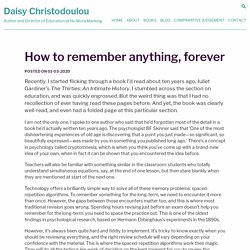
I stumbled across the section on education, and was quickly engrossed. But the weird thing was that I had no recollection of ever having read these pages before. And yet, the book was clearly well-read, and even had a folded page at this particular section. I am not the only one. I spoke to one author who said that he’d forgotten most of the detail in a book he’d actually written ten years ago. Teachers will also be familiar with something similar in the classroom: students who totally understand simultaneous equations, say, at the end of one lesson, but then stare blankly when they are mentioned at start of the next one. Technology offers a brilliantly simple way to solve all of these memory problems: spaced-repetition algorithms. However, it’s always been quite hard and fiddly to implement. Cutting workload – a couple of ideas. There isn’t a huge amount of slack in your average teacher’s day.

There’s always a lot to do in a job that generally seems to be moving too fast. Teachers work long hours, and though things have improved over the last few years, at the best of times teachers are still working around 50 hours a week, with sizeable chunks done on the weekend. People have tried all sorts of things to cut workload down, and I wanted to start with things that, in my experience, don’t help: Telling people to go home early/closing the school at 5.30pm: if people have a task that will take x hours to do, you don’t help them by limiting their ability to actually do it.
This should be obvious, but the number of times I have been told “don’t stay too late!” As such, the way I see it, there are two main, overarching issues to do with workload: The #1 problem/weakness in teaching and how to address it. I see a lot of lessons – hundreds of them in multiple contexts – and I’m going to suggest that there is one very common challenge that teachers face that is often not addressed well enough, even by experienced teachers.
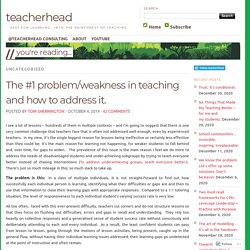
In my view, it’s the single biggest reason for lessons being ineffective or certainly less effective than they could be; it’s the main reason for learning not happening, for weaker students to fall behind and, over time, for gaps to widen. The prevalence of this issue is the main reason I feel we do more to address the needs of disadvantaged students and under-achieving subgroups by trying to teach everyone better instead of chasing interventions (To address underachieving groups, teach everyone better.). Learning in the time of coronavirus: planning distance schooling.
How do we keep teaching if schools are closed?
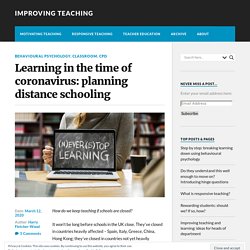
It won’t be long before schools in the UK close. They’ve closed in countries heavily affected – Spain, Italy, Greece, China, Hong Kong; they’ve closed in countries not yet heavily affected – like Denmark and Poland; and it seems to help. Closures may last a couple of weeks, but they may be much longer: schools in Hong Kong closed for two weeks in January; they are due to start reopening from mid-April to mid-May. My current hunch is that they will close next week – and won’t reopen immediately after the holidays. We’re not ready. How can we avoid disaster?
This post examines five challenges schools face, shares my experience in addressing them, and suggests implications for teachers. How I use Technology to ease my Workload – SimonBaddeley64. I have taught English in the UK for nearly 2 decades and am now at the point where I rarely take work home with me.
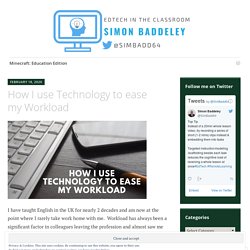
Workload has always been a significant factor in colleagues leaving the profession and almost saw me leave under my previous Multi Academy Trust. It doesn’t have to be this way. I have always been a keen technology enthusiast in education but firmly believe the technology should be the best supporting actor not the star of the show. Principles of Instruction – The Early Career Hub. Principle 1: Begin a lesson with a short review of previous learning: Daily review can strengthen previous learning and can lead to fluent recall.
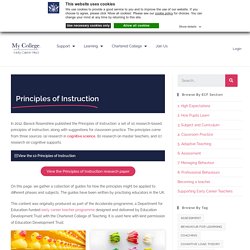
Principle 2. Present new material in small steps with student practice after each step. Only present small amounts of new material at any time, and then assist students as they practice this material. Principle 3. Ask a large number of questions and check the responses of all students: Questions help students practice new information and connect new material to their prior learning. Principle 4. Principle 5. Principle 6. Principle 7. Principle 8. Principle 9.